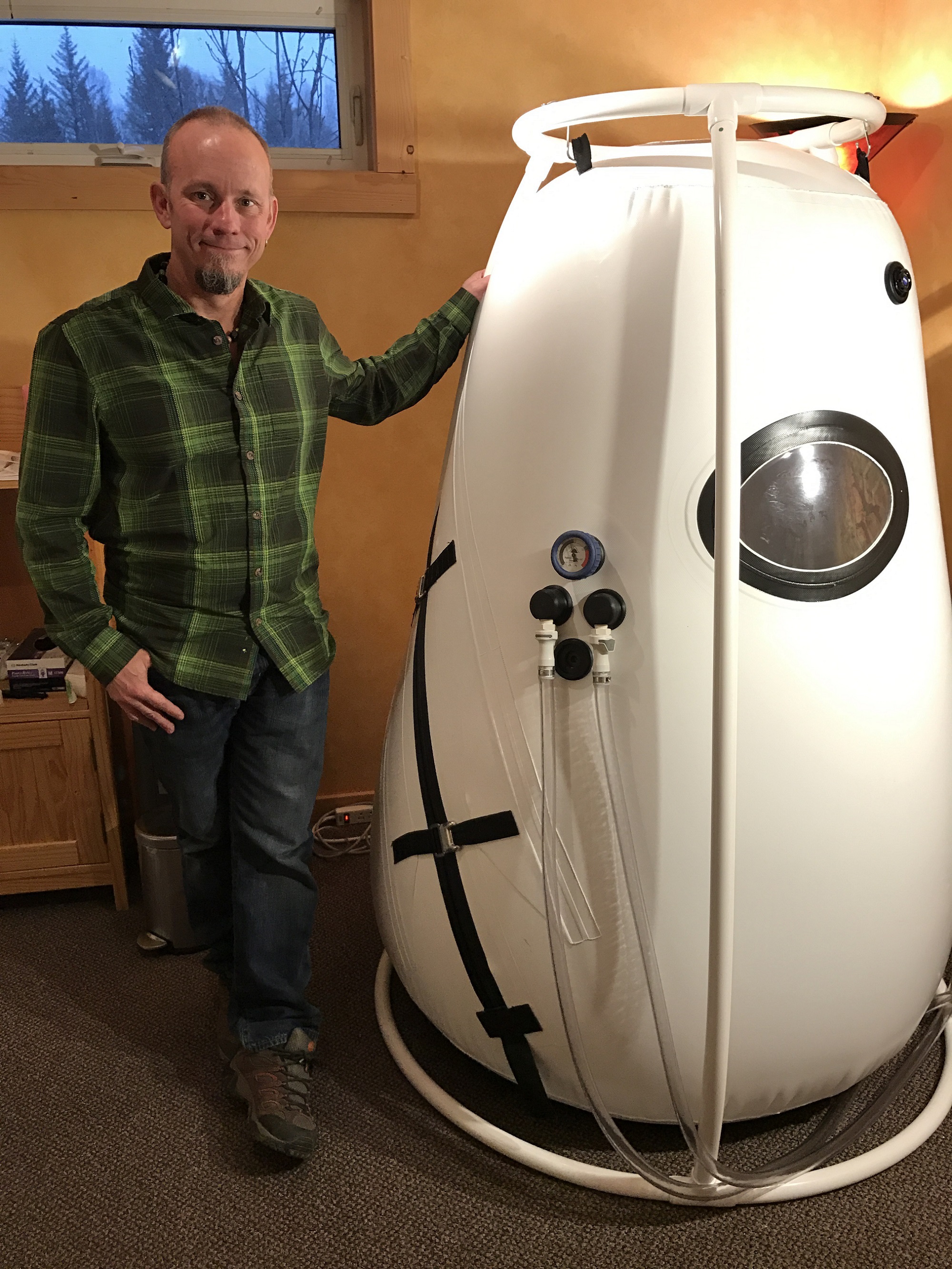Dr. Patrick Huffman and his staff joke that they may nickname the latest tool in their disease-fighting arsenal R2-O2.
The resemblance of the low-pressure hyperbaric oxygen chamber in Huffman’s Frontier Natural Health office in Homer to the beloved Star Wars’ robot character R2-D2 is hard to miss. The hyperbaric chamber is white and cylindrical and looks almost to have a face like R2-D2. Both have dials and gauges. Both are resourceful in the way they work — and, yes, both are a little tech-y.
Huffman has been practicing holistic naturopathic medicine on the Kenai Peninsula for 19 years, with offices in Soldotna and Homer. For the past 10 years, he has offered high-pressure oxygen therapy in his Soldotna office.
The low-pressure chamber that was recently added in Homer and the high-pressure chamber in Soldotna are the only publicly available hyperbaric oxygen treatment tanks on the Kenai Peninsula, as far as Huffman knows.
In general, hyperbaric oxygen therapy works by increasing the ability of blood cells to carry oxygen throughout the body by as much as 10 to 20 percent by increasing the atmospheric pressure, says Huffman.
That’s a good thing because oxygen is good for the healing process, he says.
“There’s a low potential for any harm and a lot of potential to help all parts of the body,” says Huffman. “It’s really a unique thing.”
Ears and lungs may be susceptible to the change in atmospheric pressure — with ear pain being the most common negative effect of the oxygen therapy, but that’s a short list of negatives compared to most drug treatment options.
The list of positive side effects is impressive: faster healing times, more energy and more mental clarity, not to mention helping with recovery from brain injury and trauma to the central nervous system.
High-pressure hyperbaric oxygen therapy has been around a long time. Most people may know it as the way to treat “the bends,” or decompression sickness — which can happen when one surfaces from a dive.
Several other conditions also benefit from the treatment, including stasis, or diabetic, ulcers; carbon monoxide poisoning; slow-healing surgical wounds; severe burns; bone infections; and crush injuries.
It’s well accepted in the medical community that these conditions respond well to oxygen therapy and may be covered by insurance, says Huffman.
More recently, people with multiple sclerosis, those who have suffered a stroke and those who have experienced a traumatic brain injury also have been found to benefit greatly from the use of high-pressure hyperbaric oxygen treatment.
“I have personally seen extremely good responses to these in my practice,” says Huffman.
Oxygen therapy is used far more extensively in Europe than in the United States, with open heart surgery sometimes performed in a hyperbaric tank, says Huffman.
Although it has not been around as long or studied as thoroughly, low-pressure hyperbaric oxygen treatment has been used successfully in treating concussions, fibromyalgia, chronic fatigue syndrome, migraines, multiple sclerosis, irritable bowel syndrome, Crohn’s Disease, retinal artery occlusion and autism, says Huffman. It also has helped wound healing in the elderly and cancer patients who have undergone radiation treatments.
It’s also used by athletes to improve their performance.
At $100 a session, low-pressure hyperbaric oxygen treatment is a lower-cost option than high-pressure treatment, but it is not yet reimbursable by most insurance, says Huffman.
Depending on the condition, treatments are generally done in a series of 10 to 20, says Huffman. The low-pressure treatments have been available in Homer since October.
In the low-pressure oxygen treatment, patients sit in a chair enclosed in the chamber. Many of them wear headsets and listen to their favorite music while breathing pure oxygen from a concentrator. The atmospheric pressure inside the chamber is increased to levels that resemble the pressure of a dive about 20 feet underwater.
In the high-pressure treatment, patients lie enclosed in a clear cylinder, while the atmosphere pressure is increased to levels that resemble the pressure whne one is 33 to 66 feet underwater.
Each oxygen treatment takes about an hour.
Patients can make self referrals to use the oxygen treatments. In these cases, a check of ear and lung health is required before treatment begins.
In the case of doctor referrals, a patient just needs to call and set up an appointment.
In his almost 20 years of practice on the Kenai Peninsula, Huffman has seen a growing acceptance of naturopathic medicine. He was the only naturopath in the area back then. Now there are several offices that offer what some refer to as alternative medicine, but what Huffman notes more closely resembles traditional medicine than most doctors’ offices.
Huffman received his medical degree from The National College of Naturopathic Medicine and also holds a bachelor’s degree in health science from James Madison University.
Naturopathy’s philosophies of treating the cause instead of the symptom and using the least potentially harmful method of treatment first appealed to him.
His office in Homer is located at 1020 East Road; phone, 235-3665. His office in Soldotna is 33840 Polar St.; phone, 260-7725. Hours are by appointment only.


